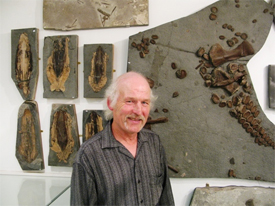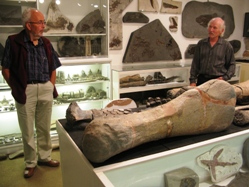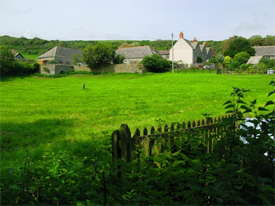Ted Nield visits the private museum of a palaeontological pioneer as he nears what he hopes will be the end of a 20-year quest.
Geoscientist 22.09 October 2012

Those who once perused the introduction to British Mesozoic Fossils, the British Museum (Natural History)’s essential – and once ubiquitous - fossil-hunter’s guide) may remember the following line from its introduction: “The Kimmeridge Clay is probably the least attractive to the fossil collector of all the British Jurassic formations”.
Fossilist extraordinaire Steve Etches (above, with (left) some of his unique collection of fossil teuthids) would beg to differ. He has amassed a lifetime’s collection of thousands of exquisitely preserved and prepared specimens, many completely new to science, that say otherwise. Next month, he should hear if his 20-year battle to have it displayed in a registered museum with proper access for public and researchers, is finally over. “If it is,” he told me, “I am going to have that quote carved over the front door!”

Walking into Steve’s house, in the almost impossibly picturesque Dorset village of Kimmeridge, neatly demonstrated the two sides of his life. On the drive were parked two vans marked “Webber & Etches Ltd., plumbing and heating engineers”. Inside, after being ushered through kitchen and lounge, I found myself in a windowless outbuilding where, as the lights flickered on, I saw was lined with exquisite fossils - Steve’s over-riding passion – together with the framed accolades he has garnered from the world of geology. The Palaeontological Association’s Award to Amateur Palaeontologists came first, in 1993; followed by the R H Worth Prize of the Geological Society (1994), the Mary Anning Award of the Palaeontological Association (2005) and most recently, the Geologists’ Association’s Halstead Medal (2006). That Steve has had to sacrifice the wall space needed to put them on display, suggests how much they mean to him.
First fossil
Steve was five when he collected his first fossil - an echinoid flint cast, which he put into his mother’s button box for safe keeping. Fourth of five children, he accompanied his father on his work as a commercial and industrial photographer, and if they finished work early they would go together to remote beaches, collecting anything of interest.
 Image : Steve Etches shows off his collection to Professor Chris Wilson
Image : Steve Etches shows off his collection to Professor Chris Wilson
“I spent most of my early childhood searching for things” says Steve: “birds’ nests, badger holes, dropped coins, spent gun cartridges – anything. I was not really interested in most subjects taught at school. I saw no point in sport and hated team games. I was always a loner and liked nothing better than to go off on my own. At the seaside I didn’t sunbathe – I found it very dull – and so went and investigated the rocks.” Steve’s enthusiasm for his collection is, and by his own account always was, infectious – his first convert being his own father.
It is easy to understand why. Steve is not a collector of any and all spectacular fossils. His cabinet of curiosities consists solely of “anything that lived in, on, or swam or flew above the Kimmeridgian sea”, and his interest in his specimens lies not just in their beauty as objects, or even in the thrill of finding and revealing something new to science, but for what they can tell us about life and death in the Kimmeridgian. It is this enthusiasm for the fossils as once living objects, and their post-mortem history, that makes Steve a truly inspiring guide to his material.
The first thing I noticed was a huge sauropod humerus centre stage, but as Steve flitted from specimen to specimen, hardly knowing where to begin, I began to see the exquisite lagerstätte-like preservation - of cartilaginous material in the fossil sharks, the world-beating quantity and quality of his pterosaur specimens, the insects – dragonfly wings (‘delicate filmed as new spun silk’ as Hardy might have said); the teuthids with soft parts preserved, the lobsters, barnacles, and the first ammonite egg-cases ever discovered.
Resource
Steve has always seen his collection as a learning resource for public and researchers; but making it happen has been a long and arduous job. Almost 20 years ago there was a project to build a new museum in Swanage - which was strangled by red tape. Others offered attractive venues, but at unsustainable rents. A quarry owner once offered a free building, only for the Council to refuse planning permission. A projected museum cum tea room seemed poised to draw down then-available rural development grants for the restoration of disused rural buildings - but foundered when it was discovered that the disused barn in question was listed. Cooperation with Lulworth Heritage Centre – where Steve currently has an exhibition based on the striking evidence of predation between species in the Kimmeridgian - has been valuable experience; but the location is obscure and the Centre has to charge entry.

Image : Still in preparation and not completed a complete new species of Ichthyosaur from the Upper Kimmeridge Clay.
Things began to look up, however, when local landlord Dr Philip Mansel proposed making available a greenfield site in Kimmeridge village available for a combined Museum of Jurassic Marine Life and village hall. This proposal, now going under the general heading of ‘The Kimmeridge Project’ has met with universal local approval (surely itself a first in rural planning history) and garnered pledges of funding from a green energy firm, the landfill tax credit scheme and a US hospital trust.
At the suggestion of the Heritage Lottery Fund Steve showed his collection to John Woodward, former Director of Bovington Tank Museum, for whose recent revamp he raised £25m, much from the HLF. Woodward took one look and immediately offered his services as a project manager - advising that only the HLF could really do the project justice. Next month, they will hear whether the resulting bid has been successful - that they are finally on track to the £2m that the Project needs.
Steve’s mood is upbeat, but he has known too much disappointment to count chickens yet. There’s a glint of steel; just as he would never sell his collection, he won’t ‘sell out’, either. He’s no pushover; he wants things the way he wants them, and that’s that. “What’s the point otherwise?” he says. He also has very definite ideas about museums, and how the material should be presented. He no more wants ‘dumbing down’ than screeds of minute, learned text. Nor does he want people goggling ignorantly at things they don’t understand, too afraid to question, or unable to find someone to ask. He wants all guided, ideally in-person, tours – pre-recorded, failing that - so that people actually do learn about what they are seeing.
Recognised Muesum
That glint of inner steel shines off Steve’s absolute (and entirely justified) confidence in the worth of his collection. “We have the world’s finest ichthyosaur material from the Kimmeridge. The NHM may have the best fish collection, but for the Kimmeridge, ours is far superior. For pterosaurs, there’s no-one to beat us. I know what I’ve got. I know it can’t be replicated anywhere else...” though lest this sound like personal grandstanding, he quickly adds: “But it’s the collection that’s important – and that it should be held in a Recognised Museum.”
Steve has been overwhelmed by pledges of support for the Kimmeridge Project from university and museum academics, and expert individuals in the UK and abroad. He quotes Professor Desmond Donovan, who recently sighed, with a shake of the head: “I’ve worked on these things all my life, and yet you are showing me stuff I have never seen before.”
If all goes well, we shall soon all be able to see stuff we’ve never seen before – and could never see anywhere else.
- To find out more about the Kimmeridge Project: www.kimmeridgeproject.org
- You can obtain a copy of Steve’s book (written with Jane Clark), Life in Jurassic Seas – the autobiography of a fossil collector, by emailing Steve directly at [email protected]. The book is privately printed, has no ISBN and is not available retail or online.